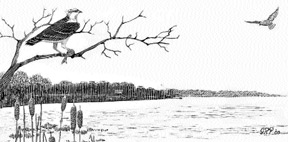Earth Journal
In Season: Osprey
story and illustration by Gary Pendleton

Have you seen an osprey yet?
My wife Karyn asked me that question some 10 days ago, around the first of March. There had already been sightings on the Patuxent, she reported.
No, not yet, not here in North Beach, I hadn’t seen one. I still haven’t seen my first osprey of the year, but I really need to get out more.
St. Patrick’s Day is the time I think of as marking osprey arrival, but according to the third edition of Field List of the Birds of Maryland, February 3 is when the very earliest fish hawks are expected to appear. Earlier editions said February 28. I wonder if the update is an indication of global warming. I also wonder if this year’s harsh weather affected any early arrivers.
There is a fairly wide evolutionary gap between osprey and their closest relatives, hawks and eagles. The gap is exemplified by some unique characteristics of the osprey’s feet. They have unusually large talons, a reversible outer toe and spines on their soles. These adaptations make it easier for them to catch fish, which are their sole source of food. They are so different from any other species that many ornithologists place osprey in their own sub-family.
North American osprey breed in coastal areas throughout Canada and the United States, but their winters are spent south of the border. They are among a small number of species that are considered cosmopolitan, a loose scientific term that suggests a global presence.
By the time spring officially arrives, I predict that ospreys will be a common sight along our waterways. It wasn’t always so. During the 1950s and ’60s, they were driven to the brink of extinction by the effects of DDT. Now their increased presence is a welcome sight to which I’m looking forward.
